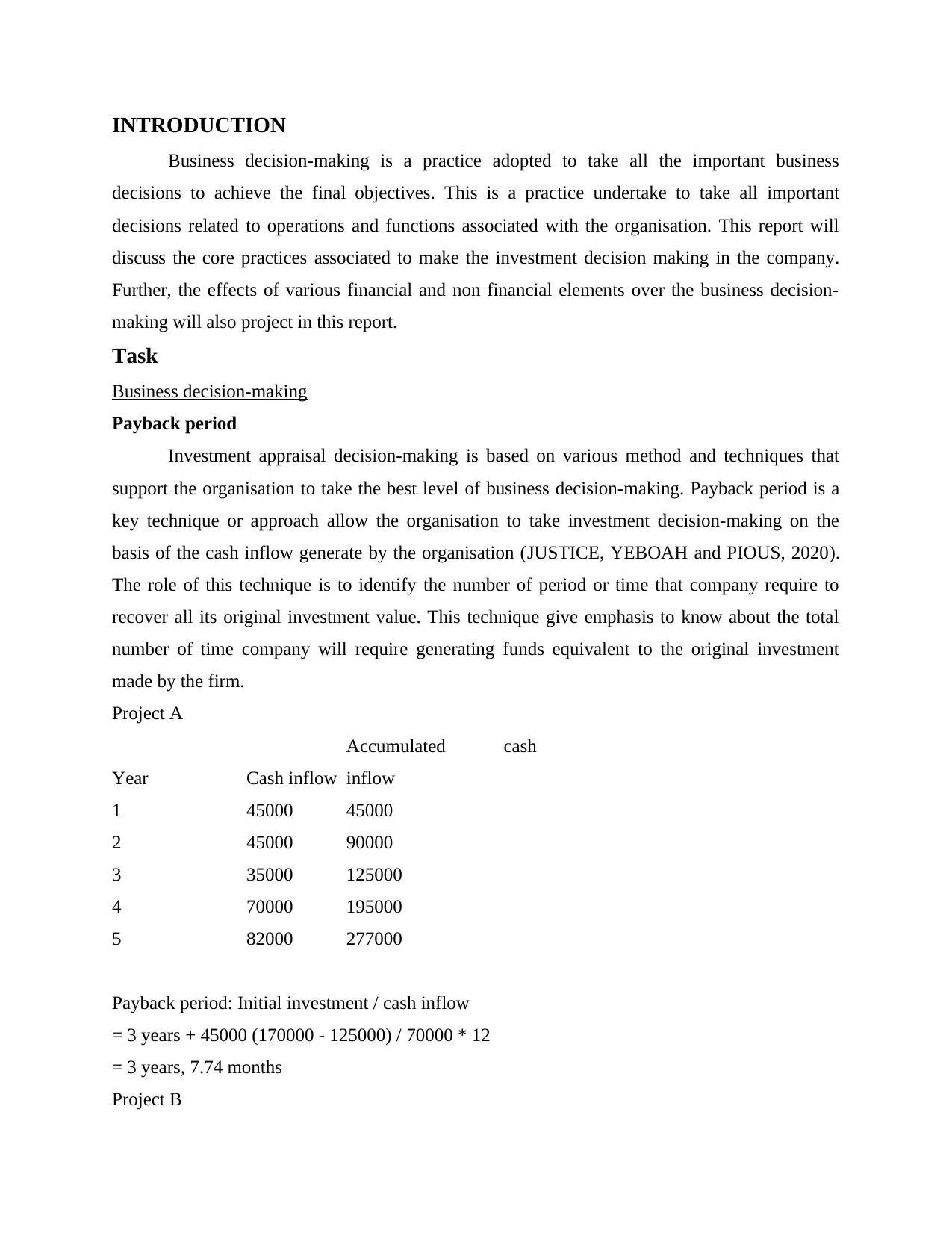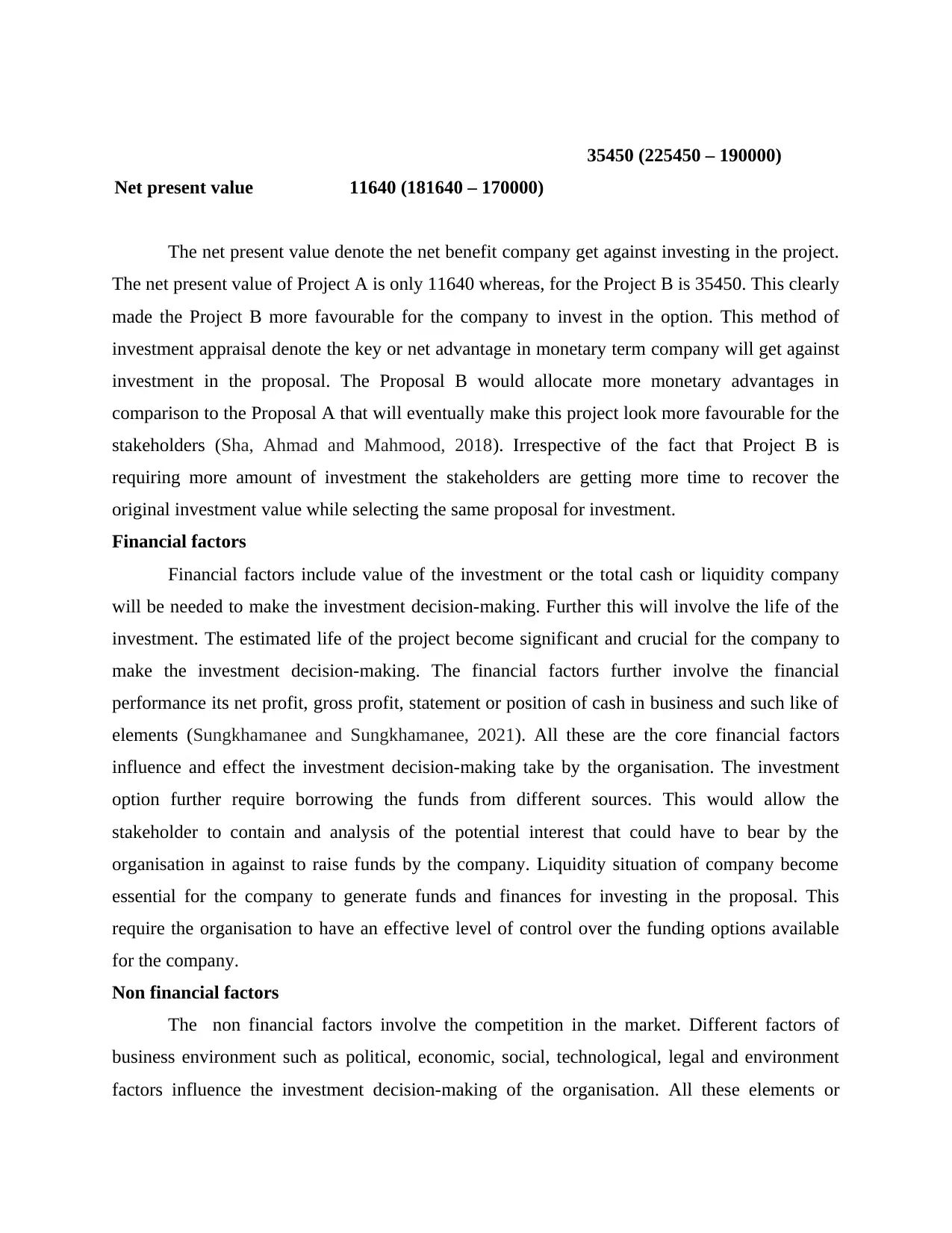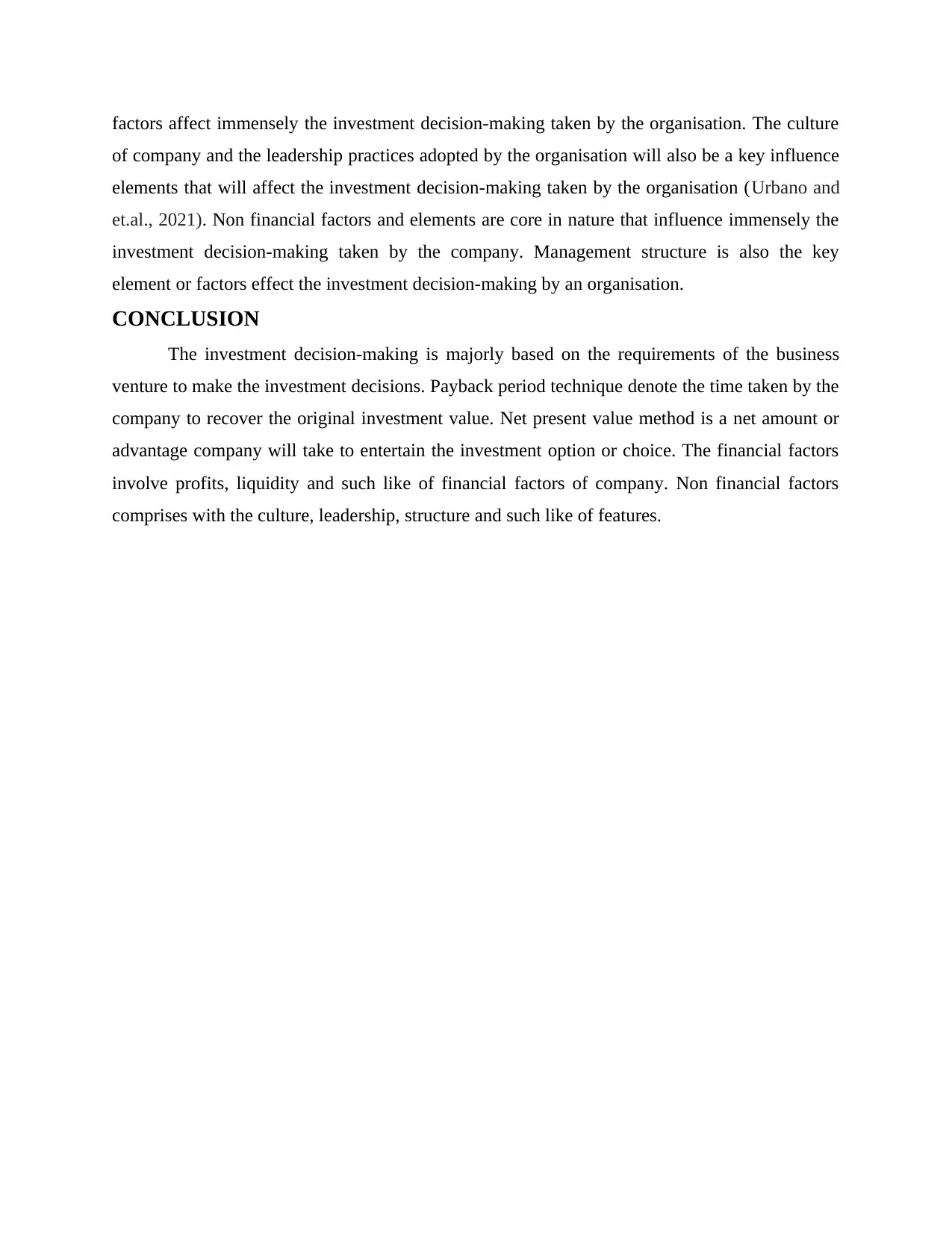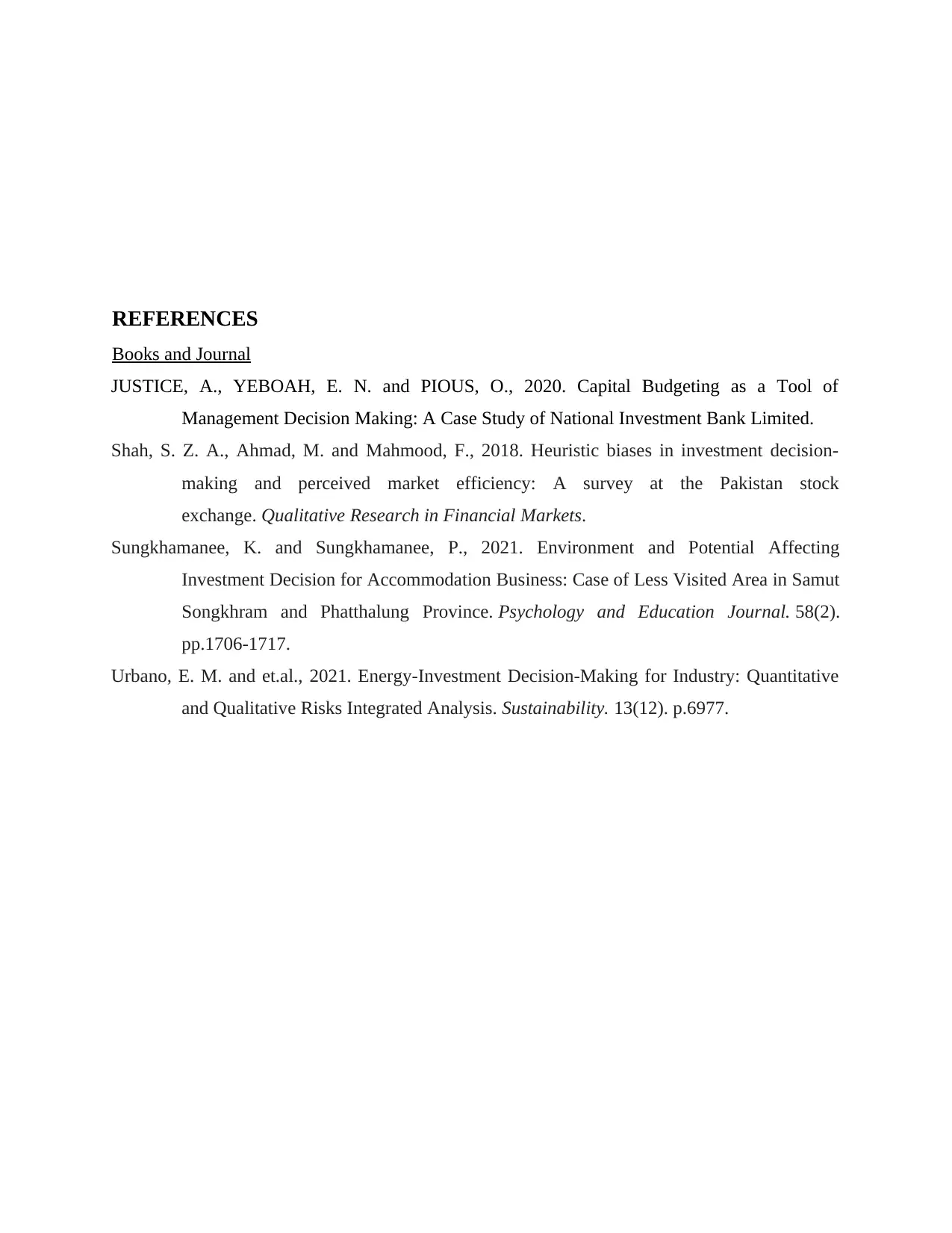Investment Decision-Making: Appraisal Methods and Influencing Factors
VerifiedAdded on 2023/06/18
|7
|1217
|249
Report
AI Summary
This report explores business decision-making through the lens of investment appraisal methods, focusing on the payback period and net present value (NPV) techniques. It assesses two projects, A and B, using these methods to determine the more favorable investment option. Project B is identified as superior due to its shorter payback period and higher NPV. The report also discusses the influence of financial factors such as investment value, project life, and liquidity, as well as non-financial factors like market competition, business environment (political, economic, social, technological, legal, and environmental), company culture, and management structure on investment decisions. The conclusion emphasizes the importance of both financial and non-financial considerations in effective investment decision-making.

BUSINESS DECISION
MAKING
MAKING
Paraphrase This Document
Need a fresh take? Get an instant paraphrase of this document with our AI Paraphraser

Table of Contents
INTRODUCTION...........................................................................................................................3
Task .................................................................................................................................................3
Business decision-making............................................................................................................3
CONCLUSION................................................................................................................................6
REFERENCES................................................................................................................................7
INTRODUCTION...........................................................................................................................3
Task .................................................................................................................................................3
Business decision-making............................................................................................................3
CONCLUSION................................................................................................................................6
REFERENCES................................................................................................................................7

INTRODUCTION
Business decision-making is a practice adopted to take all the important business
decisions to achieve the final objectives. This is a practice undertake to take all important
decisions related to operations and functions associated with the organisation. This report will
discuss the core practices associated to make the investment decision making in the company.
Further, the effects of various financial and non financial elements over the business decision-
making will also project in this report.
Task
Business decision-making
Payback period
Investment appraisal decision-making is based on various method and techniques that
support the organisation to take the best level of business decision-making. Payback period is a
key technique or approach allow the organisation to take investment decision-making on the
basis of the cash inflow generate by the organisation (JUSTICE, YEBOAH and PIOUS, 2020).
The role of this technique is to identify the number of period or time that company require to
recover all its original investment value. This technique give emphasis to know about the total
number of time company will require generating funds equivalent to the original investment
made by the firm.
Project A
Year Cash inflow
Accumulated cash
inflow
1 45000 45000
2 45000 90000
3 35000 125000
4 70000 195000
5 82000 277000
Payback period: Initial investment / cash inflow
= 3 years + 45000 (170000 - 125000) / 70000 * 12
= 3 years, 7.74 months
Project B
Business decision-making is a practice adopted to take all the important business
decisions to achieve the final objectives. This is a practice undertake to take all important
decisions related to operations and functions associated with the organisation. This report will
discuss the core practices associated to make the investment decision making in the company.
Further, the effects of various financial and non financial elements over the business decision-
making will also project in this report.
Task
Business decision-making
Payback period
Investment appraisal decision-making is based on various method and techniques that
support the organisation to take the best level of business decision-making. Payback period is a
key technique or approach allow the organisation to take investment decision-making on the
basis of the cash inflow generate by the organisation (JUSTICE, YEBOAH and PIOUS, 2020).
The role of this technique is to identify the number of period or time that company require to
recover all its original investment value. This technique give emphasis to know about the total
number of time company will require generating funds equivalent to the original investment
made by the firm.
Project A
Year Cash inflow
Accumulated cash
inflow
1 45000 45000
2 45000 90000
3 35000 125000
4 70000 195000
5 82000 277000
Payback period: Initial investment / cash inflow
= 3 years + 45000 (170000 - 125000) / 70000 * 12
= 3 years, 7.74 months
Project B
⊘ This is a preview!⊘
Do you want full access?
Subscribe today to unlock all pages.

Trusted by 1+ million students worldwide

Year Cash inflow
Accumulated cash
inflow
1 50000 50000
2 45000 95000
3 70000 165000
4 90000 255000
5 90000 345000
Payback period: 3 years + 25000 (190000 + 165000) / 90000 * 12
= 3 Years and 3.33 Months
The project B contain less time to recover the original investment than the Project A. On
the basis of the payback period technique Project B look more favourable for the company in
comparison to the Project A. This technique support such proposal that seek less time to recover
the original investment value. In context to both the projects B require less time that is 3 years
and 3.33 months on the other hand Project A need 3 years and 7.74 months. This clearly state the
fact the stakeholders can get more advantage for investing in Project B as it allow the company
to recover its investment early in comparison to other proposals.
Net present value method
Project A Project B
Year
Discounted value
@ 14%
Cash
inflow
Present value of
cahs inflow
Cash
inflow
Present value of
cash inflow
1 0.88 45000 39600 50000 44000
2 0.77 45000 34650 45000 34650
3 0.67 35000 23450 70000 46900
4 0.59 70000 41300 90000 53100
5 0.52 82000 42640 90000 46800
181640 225450
Initial investment 170000 190000
Accumulated cash
inflow
1 50000 50000
2 45000 95000
3 70000 165000
4 90000 255000
5 90000 345000
Payback period: 3 years + 25000 (190000 + 165000) / 90000 * 12
= 3 Years and 3.33 Months
The project B contain less time to recover the original investment than the Project A. On
the basis of the payback period technique Project B look more favourable for the company in
comparison to the Project A. This technique support such proposal that seek less time to recover
the original investment value. In context to both the projects B require less time that is 3 years
and 3.33 months on the other hand Project A need 3 years and 7.74 months. This clearly state the
fact the stakeholders can get more advantage for investing in Project B as it allow the company
to recover its investment early in comparison to other proposals.
Net present value method
Project A Project B
Year
Discounted value
@ 14%
Cash
inflow
Present value of
cahs inflow
Cash
inflow
Present value of
cash inflow
1 0.88 45000 39600 50000 44000
2 0.77 45000 34650 45000 34650
3 0.67 35000 23450 70000 46900
4 0.59 70000 41300 90000 53100
5 0.52 82000 42640 90000 46800
181640 225450
Initial investment 170000 190000
Paraphrase This Document
Need a fresh take? Get an instant paraphrase of this document with our AI Paraphraser

Net present value 11640 (181640 – 170000)
35450 (225450 – 190000)
The net present value denote the net benefit company get against investing in the project.
The net present value of Project A is only 11640 whereas, for the Project B is 35450. This clearly
made the Project B more favourable for the company to invest in the option. This method of
investment appraisal denote the key or net advantage in monetary term company will get against
investment in the proposal. The Proposal B would allocate more monetary advantages in
comparison to the Proposal A that will eventually make this project look more favourable for the
stakeholders (Sha, Ahmad and Mahmood, 2018). Irrespective of the fact that Project B is
requiring more amount of investment the stakeholders are getting more time to recover the
original investment value while selecting the same proposal for investment.
Financial factors
Financial factors include value of the investment or the total cash or liquidity company
will be needed to make the investment decision-making. Further this will involve the life of the
investment. The estimated life of the project become significant and crucial for the company to
make the investment decision-making. The financial factors further involve the financial
performance its net profit, gross profit, statement or position of cash in business and such like of
elements (Sungkhamanee and Sungkhamanee, 2021). All these are the core financial factors
influence and effect the investment decision-making take by the organisation. The investment
option further require borrowing the funds from different sources. This would allow the
stakeholder to contain and analysis of the potential interest that could have to bear by the
organisation in against to raise funds by the company. Liquidity situation of company become
essential for the company to generate funds and finances for investing in the proposal. This
require the organisation to have an effective level of control over the funding options available
for the company.
Non financial factors
The non financial factors involve the competition in the market. Different factors of
business environment such as political, economic, social, technological, legal and environment
factors influence the investment decision-making of the organisation. All these elements or
35450 (225450 – 190000)
The net present value denote the net benefit company get against investing in the project.
The net present value of Project A is only 11640 whereas, for the Project B is 35450. This clearly
made the Project B more favourable for the company to invest in the option. This method of
investment appraisal denote the key or net advantage in monetary term company will get against
investment in the proposal. The Proposal B would allocate more monetary advantages in
comparison to the Proposal A that will eventually make this project look more favourable for the
stakeholders (Sha, Ahmad and Mahmood, 2018). Irrespective of the fact that Project B is
requiring more amount of investment the stakeholders are getting more time to recover the
original investment value while selecting the same proposal for investment.
Financial factors
Financial factors include value of the investment or the total cash or liquidity company
will be needed to make the investment decision-making. Further this will involve the life of the
investment. The estimated life of the project become significant and crucial for the company to
make the investment decision-making. The financial factors further involve the financial
performance its net profit, gross profit, statement or position of cash in business and such like of
elements (Sungkhamanee and Sungkhamanee, 2021). All these are the core financial factors
influence and effect the investment decision-making take by the organisation. The investment
option further require borrowing the funds from different sources. This would allow the
stakeholder to contain and analysis of the potential interest that could have to bear by the
organisation in against to raise funds by the company. Liquidity situation of company become
essential for the company to generate funds and finances for investing in the proposal. This
require the organisation to have an effective level of control over the funding options available
for the company.
Non financial factors
The non financial factors involve the competition in the market. Different factors of
business environment such as political, economic, social, technological, legal and environment
factors influence the investment decision-making of the organisation. All these elements or

factors affect immensely the investment decision-making taken by the organisation. The culture
of company and the leadership practices adopted by the organisation will also be a key influence
elements that will affect the investment decision-making taken by the organisation (Urbano and
et.al., 2021). Non financial factors and elements are core in nature that influence immensely the
investment decision-making taken by the company. Management structure is also the key
element or factors effect the investment decision-making by an organisation.
CONCLUSION
The investment decision-making is majorly based on the requirements of the business
venture to make the investment decisions. Payback period technique denote the time taken by the
company to recover the original investment value. Net present value method is a net amount or
advantage company will take to entertain the investment option or choice. The financial factors
involve profits, liquidity and such like of financial factors of company. Non financial factors
comprises with the culture, leadership, structure and such like of features.
of company and the leadership practices adopted by the organisation will also be a key influence
elements that will affect the investment decision-making taken by the organisation (Urbano and
et.al., 2021). Non financial factors and elements are core in nature that influence immensely the
investment decision-making taken by the company. Management structure is also the key
element or factors effect the investment decision-making by an organisation.
CONCLUSION
The investment decision-making is majorly based on the requirements of the business
venture to make the investment decisions. Payback period technique denote the time taken by the
company to recover the original investment value. Net present value method is a net amount or
advantage company will take to entertain the investment option or choice. The financial factors
involve profits, liquidity and such like of financial factors of company. Non financial factors
comprises with the culture, leadership, structure and such like of features.
⊘ This is a preview!⊘
Do you want full access?
Subscribe today to unlock all pages.

Trusted by 1+ million students worldwide

REFERENCES
Books and Journal
JUSTICE, A., YEBOAH, E. N. and PIOUS, O., 2020. Capital Budgeting as a Tool of
Management Decision Making: A Case Study of National Investment Bank Limited.
Shah, S. Z. A., Ahmad, M. and Mahmood, F., 2018. Heuristic biases in investment decision-
making and perceived market efficiency: A survey at the Pakistan stock
exchange. Qualitative Research in Financial Markets.
Sungkhamanee, K. and Sungkhamanee, P., 2021. Environment and Potential Affecting
Investment Decision for Accommodation Business: Case of Less Visited Area in Samut
Songkhram and Phatthalung Province. Psychology and Education Journal. 58(2).
pp.1706-1717.
Urbano, E. M. and et.al., 2021. Energy-Investment Decision-Making for Industry: Quantitative
and Qualitative Risks Integrated Analysis. Sustainability. 13(12). p.6977.
Books and Journal
JUSTICE, A., YEBOAH, E. N. and PIOUS, O., 2020. Capital Budgeting as a Tool of
Management Decision Making: A Case Study of National Investment Bank Limited.
Shah, S. Z. A., Ahmad, M. and Mahmood, F., 2018. Heuristic biases in investment decision-
making and perceived market efficiency: A survey at the Pakistan stock
exchange. Qualitative Research in Financial Markets.
Sungkhamanee, K. and Sungkhamanee, P., 2021. Environment and Potential Affecting
Investment Decision for Accommodation Business: Case of Less Visited Area in Samut
Songkhram and Phatthalung Province. Psychology and Education Journal. 58(2).
pp.1706-1717.
Urbano, E. M. and et.al., 2021. Energy-Investment Decision-Making for Industry: Quantitative
and Qualitative Risks Integrated Analysis. Sustainability. 13(12). p.6977.
1 out of 7
Related Documents
Your All-in-One AI-Powered Toolkit for Academic Success.
+13062052269
info@desklib.com
Available 24*7 on WhatsApp / Email
![[object Object]](/_next/static/media/star-bottom.7253800d.svg)
Unlock your academic potential
Copyright © 2020–2025 A2Z Services. All Rights Reserved. Developed and managed by ZUCOL.





